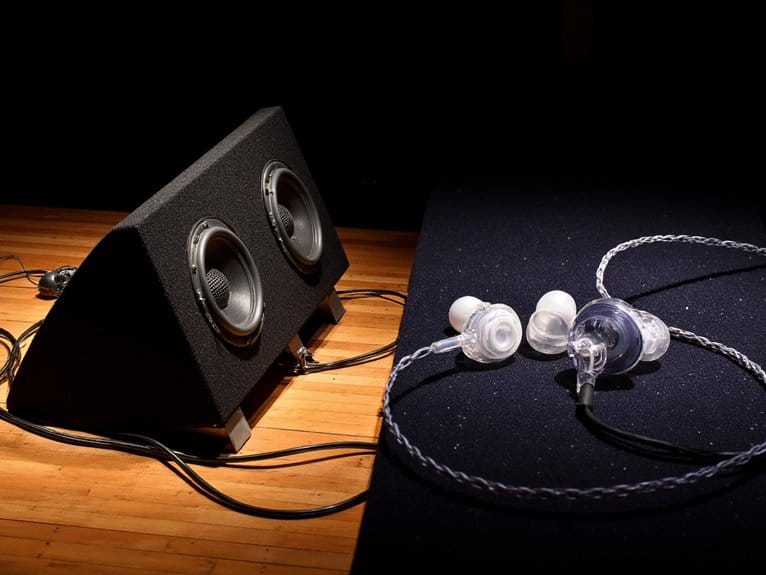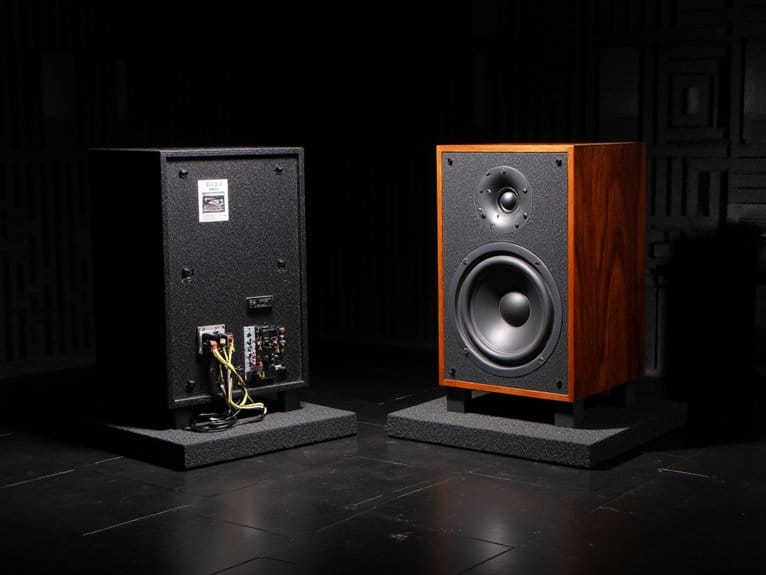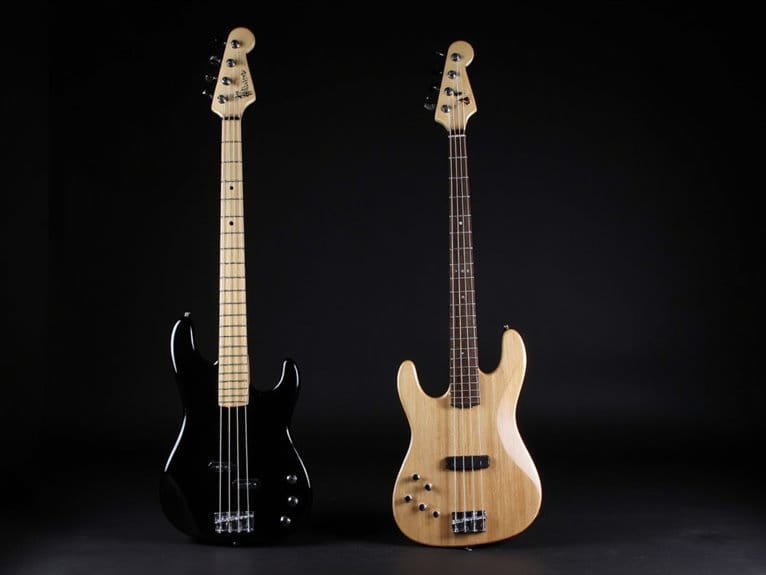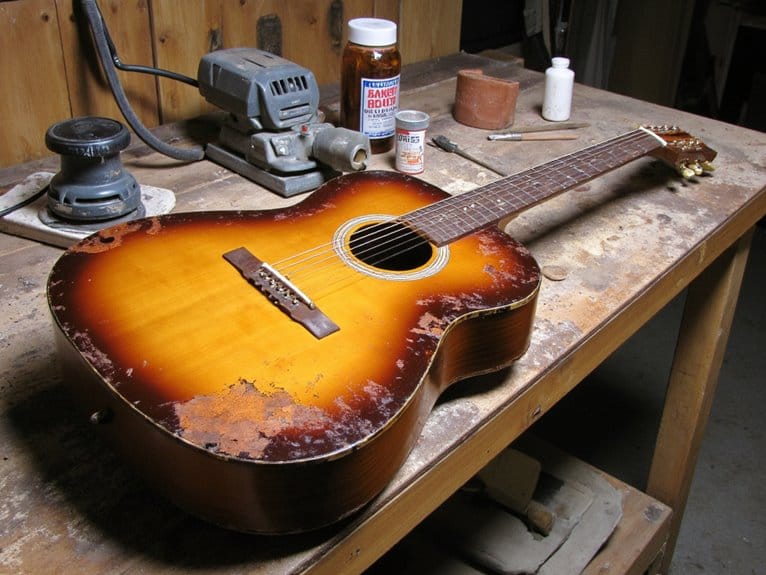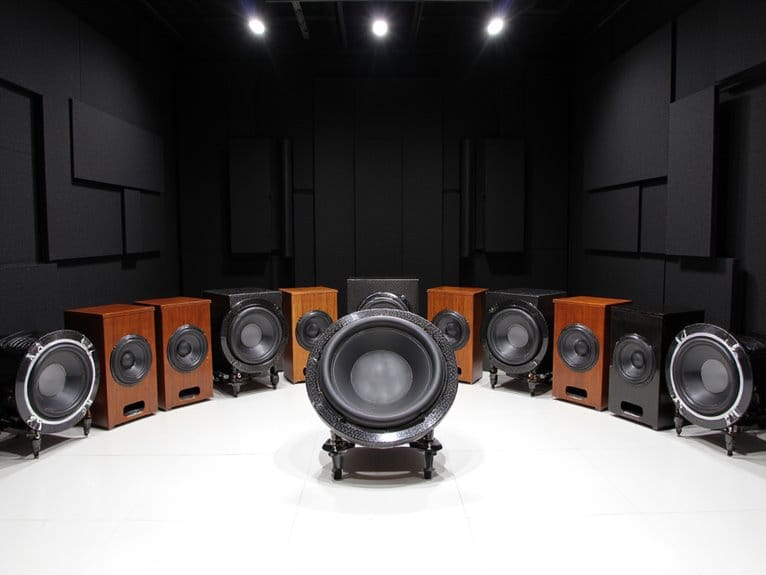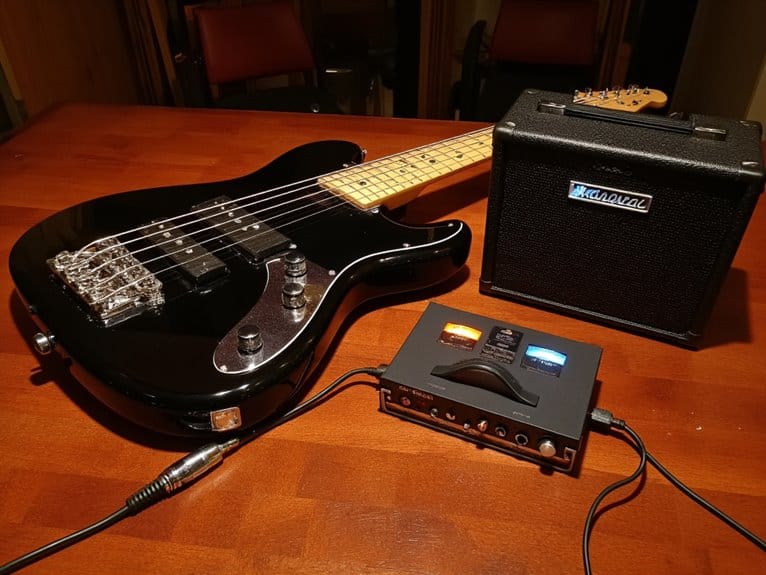In-Ear Monitors Vs Traditional Stage Monitors
You’ll find that in-ear monitors offer superior sound isolation and mix customization compared to traditional stage monitors, allowing you to move freely across the stage while hearing crystal-clear audio at safer volume levels. While IEMs cost around $1,100 per unit and require complex wireless setup, they provide up to 38 dB noise isolation and eliminate feedback issues. Traditional wedges offer simpler, cheaper solutions but confine you to fixed positions and risk hearing damage from high volumes, making venue size a vital factor in your decision.
We are supported by our audience. When you purchase through links on our site, we may earn an affiliate commission, at no extra cost for you. Learn more.
Notable Insights
- IEMs deliver superior sound isolation and consistent audio quality regardless of performer position, while traditional monitors confine artists to fixed zones.
- Wireless IEM systems enable complete stage mobility and eliminate trip hazards, but require more complex setup than traditional wedge monitors.
- IEMs protect hearing by allowing lower performance volumes with crystal-clear audio, while stage monitors risk damage from harsh frequencies.
- Traditional monitors have lower upfront costs and simpler setup, while IEMs cost around $1,100+ per unit but offer long-term value.
- Small venues typically favor traditional wedges for simplicity, while large venues benefit almost universally from IEM systems’ advanced capabilities.
Sound Quality and Mix Customization Capabilities
When it comes to sound quality and mix customization, I’ve found that in-ear monitors fundamentally transform how musicians experience their performance audio compared to traditional stage monitors.
You’ll notice dramatically improved mix clarity since IEMs deliver sound directly to your ear canal, eliminating the reflections and interference that plague wedge monitors on stage. The audio fidelity remains consistent regardless of where you’re positioned, unlike traditional monitors that change based on your distance and angle.
What’s particularly impressive is how each band member can customize their individual mix without affecting others, something I’ve seen create countless headaches with shared wedge systems. IEMs also provide superior sound isolation by blocking out ambient noise, allowing you to hear your mix clearly even in the loudest venues.
This personalized approach, combined with the elimination of phase issues and comb filtering, creates a remarkably clean monitoring environment. Quality in-ear monitors with balanced armature drivers excel in reproducing mid and high frequencies, offering exceptional clarity and detail in sound reproduction. Modern IEMs often feature hybrid driver configurations that combine dynamic drivers with balanced armatures for enhanced sound reproduction across the entire frequency spectrum. IEMs also eliminate the sound bleed that traditional wedge monitors create, preventing audio from one monitor from interfering with another musician’s mix.
Stage Mobility and Performance Freedom
When you’re performing on stage, your ability to move freely can make or break the connection with your audience, and this is where the fundamental differences between in-ear monitors and traditional wedges become most apparent.
With conventional stage monitors, you’re fundamentally tethered to specific sweet spots where the sound mix remains ideal, forcing you to choreograph your movements around these fixed audio zones rather than following your creative instincts.
I’ve watched countless performers unconsciously limit their stage presence because stepping too far from their wedges means losing critical elements of their monitor mix, effectively trading performance freedom for consistent audio.
In contrast, professional in-ear monitors like the MEE audio M6 PRO provide superior noise isolation of up to 38 dB, allowing performers to maintain consistent audio clarity regardless of their position on stage.
Modern IEMs with hybrid driver configurations ensure that guitarists receive both the precise high frequencies and robust bass response necessary for accurate stage monitoring without being anchored to a specific location.
Wireless Movement Freedom
Since I’ve spent countless hours watching performers awkwardly shuffle between fixed monitor positions, I can tell you that wireless movement freedom represents one of the most transformative advantages IEMs offer over traditional stage monitors.
Your music connection becomes seamless when you’re not tethered to stationary wedges, and the creative expression that emerges from unrestricted mobility is genuinely remarkable.
Modern wireless IEM systems deliver three critical mobility advantages:
- Reliable signal transmission with minimal latency across entire stage areas
- Battery-powered independence eliminating power cable restrictions and trip hazards
- Multi-performer compatibility supporting simultaneous users without signal congestion
You’ll discover that removing physical boundaries transforms stage presence dramatically, allowing natural audience engagement while maintaining consistent audio monitoring throughout dynamic performances.
Stage Positioning Constraints
Although wireless freedom solves mobility issues, traditional stage monitors create their own set of positioning constraints that can severely limit your performance potential.
You’ll find yourself locked into specific “sweet spots” where the monitor’s sound reaches you clearly, forcing you to sacrifice natural movement for proper audio levels. When you step outside these predetermined zones, your mix becomes muddy or disappears entirely, leaving you disconnected from the music.
Different stage configurations require completely different placement strategies, meaning what works at one venue might fail spectacularly at the next.
I’ve watched countless performers awkwardly navigate around bulky wedges, their choreography compromised by the need to stay within listening range. Your ability to engage different audience sections becomes severely restricted when monitors anchor you to fixed positions.
Performance Range Flexibility
With in-ear monitors strapped to your ears, you’ll discover a liberation that transforms how you move and perform on stage, breaking free from the invisible chains that traditional wedges create around specific listening zones.
In ear flexibility becomes your new reality as custom molds provide ergonomic benefits that enhance mobility enhancement across any venue size.
Performance adaptability reaches new heights through three key advantages:
- Sound isolation blocks environmental noise while delivering monitoring precision
- Acoustic control maintains consistent mixes regardless of stage positioning
- Wireless capability eliminates cable management concerns during dynamic performances
Traditional monitors trap you within their “sweet spots,” but IEMs grant complete freedom to engage audiences from every corner.
The ergonomic benefits of lightweight construction mean you’ll perform longer without fatigue, while custom molds guarantee comfort during extended sets, transforming your entire approach to stage presence.
Hearing Protection and Volume Management
When I first started performing professionally, I didn’t realize how much damage traditional stage monitors were doing to my hearing until I experienced ringing in my ears after nearly every show.
The constant exposure to harsh frequencies and excessive volumes was taking its toll, but switching to in-ear monitors changed everything.
IEMs excel at hearing fatigue prevention by allowing you to perform at notably lower volumes while maintaining crystal-clear audio quality.
Their sound isolation effectiveness creates a protective barrier against external stage noise, reducing your exposure to damaging frequencies.
Unlike traditional monitors that contribute to overall stage volume and feedback issues, IEMs deliver customized mixes directly into your ears, giving you precise volume control without compromising your long-term hearing health.
Professional-grade IEMs can provide up to 38 dB noise isolation, creating an even more effective shield against the harmful ambient sound levels that plague traditional stage setups.
Technical Setup Requirements and Reliability
When you’re comparing IEM systems to traditional stage monitors, you’ll quickly discover that the technical complexity differs dramatically. Wireless IEMs require frequency coordination, transmitter configuration, and individual mix creation that can extend your soundcheck by thirty to sixty minutes.
I’ve watched countless engineers struggle with RF interference issues, dead batteries during critical moments, and the inevitable scramble to troubleshoot wireless dropouts that never seem to happen during rehearsal.
Your traditional wedge monitors, while less flexible, offer the reliability of hardwired connections and the simplicity of shared mixes that can get your band stage-ready in a fraction of the time.
Wireless System Complexity
Once you plunge into wireless IEM systems, you’ll quickly discover that their technical complexity far exceeds traditional wedge monitors. This complexity requires careful frequency coordination, sophisticated signal routing, and multiple interconnected components that must work seamlessly together.
Your signal transmission depends on precise channel allocation across crowded RF environments, where interference becomes your biggest enemy. Unlike simple wedge monitors that plug directly into mixing consoles, wireless systems demand meticulous planning and specialized knowledge.
The setup complexity involves three critical components:
- Frequency scanning and coordination to identify available spectrum
- Audio routing from mixers through transmitters to receivers
- Antenna placement optimization for reliable signal coverage
You’ll need dedicated technicians managing rack-mounted transmitters, wireless receivers, and signal distribution routers.
Each performer requires individual mix customization, transforming what seems straightforward into a sophisticated technical challenge requiring expertise.
Battery and Interference Issues
Beyond the intricate wireless configurations lies another layer of technical challenges that can make or break your performance reliability.
Battery management becomes your constant companion with IEMs, requiring meticulous attention to charging cycles, backup units, and mid-show power levels that traditional wired monitors simply don’t demand. You’ll find yourself monitoring battery indicators like a hawk, knowing that a dead receiver means complete audio loss during critical moments.
Meanwhile, signal coordination adds another complexity layer, especially when multiple wireless IEM users share the same venue, requiring careful frequency planning to prevent cross-talk and interference.
Traditional stage monitors sidestep these concerns entirely, offering the reliability of direct power connections and freedom from RF spectrum management headaches.
Soundcheck Time Requirements
Every soundcheck tells a different story depending on your monitoring choice, and the time investment between traditional wedges and in-ear monitors creates a stark divide that’ll reshape your pre-show routine entirely.
Speaker monitors demand extensive positioning, individual volume adjustments for each performer, and careful tuning to prevent feedback loops between microphones and wedges.
You’ll spend considerable time managing cable runs, securing monitors, and making repeated EQ adjustments across multiple channels, with soundcheck efficiency suffering due to venue acoustics requiring frequent recalibration.
In-ear monitors streamline this process through:
- Pre-configured digital mixes that recall instantly at each venue
- Minimal feedback issues eliminating lengthy tuning sessions
- Reduced equipment maintenance with fewer moving parts and cables
IEMs provide consistent sound regardless of room size or acoustics, while traditional wedges require venue-specific adjustments that can delay show starts when troubleshooting becomes necessary.
Frequently Asked Questions
You shouldn’t share IEMs due to shared hygiene concerns and poor fit issues. You’ll need individual earpieces for ideal sound customization, proper isolation, and comfort. Custom-fitted options provide the best performance for your unique ear anatomy.
How Quickly Can Musicians Adapt When Switching Between IEMS and Stage Monitors?
You’ll typically adapt within days to weeks when switching between systems, though your musician flexibility improves with practice. Regular rehearsals with both monitoring types considerably enhances your performance adaptability and reduces adjustment time.
On a final note
You’ll need to weigh your specific performance needs, budget constraints, and venue requirements when choosing between in-ear monitors and traditional stage wedges. If you’re frequently moving around stage, prioritizing hearing protection, or performing in larger venues, IEMs typically offer superior benefits despite higher initial costs. However, if you’re on a tight budget or primarily playing smaller, intimate venues, traditional monitors can still deliver excellent results.

